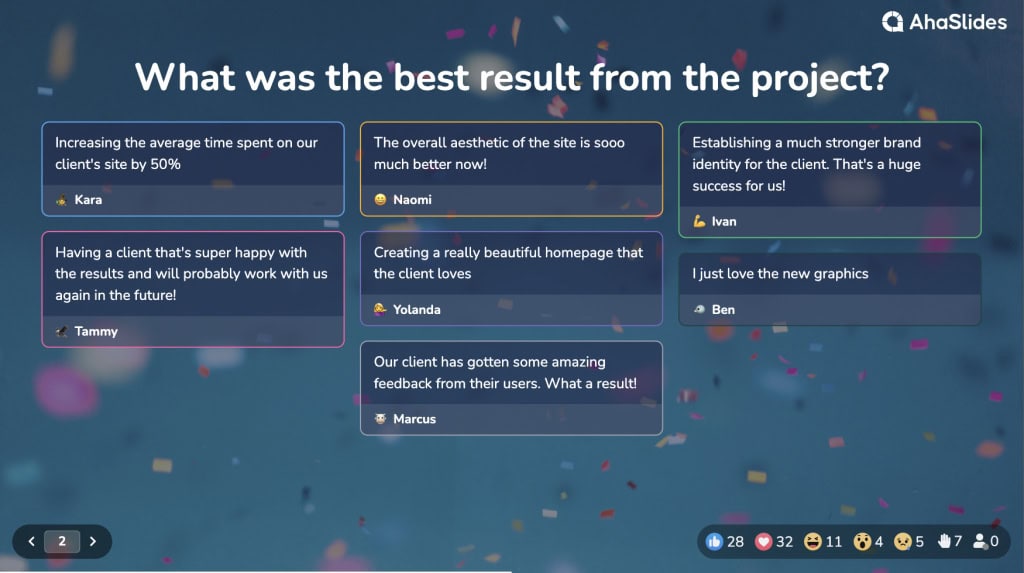ເຄີຍເຮັດສໍາເລັດໂຄງການແລ້ວຮູ້ສຶກວ່າບາງສິ່ງບາງຢ່າງອາດຈະດີຂຶ້ນບໍ? ຫຼືບາງທີເຈົ້າໄດ້ຕີມັນອອກຈາກສວນສາທາລະນະ, ແຕ່ບໍ່ສາມາດເອົານິ້ວມືຂອງເຈົ້າໃສ່ໄດ້ ເປັນຫຍັງ? ນັ້ນແມ່ນບ່ອນທີ່ ໂຄງການສໍາລັບການຄືນຫລັງ ເຂົ້າມາ. ພວກມັນຄືກັບບົດສະຫຼຸບສຳລັບທີມຂອງເຈົ້າ, ໂອກາດທີ່ຈະສະເຫຼີມສະຫຼອງໄຊຊະນະ, ຮຽນຮູ້ຈາກອາການສະຫຼົບ, ແລະຕັ້ງເວທີໃຫ້ປະສົບຜົນສຳເລັດຍິ່ງຂຶ້ນໃນອະນາຄົດ.
ໂຄງການ Retrospective ແມ່ນຫຍັງ?
ໂຄງການ retrospective, ບາງຄັ້ງເອີ້ນວ່າກອງປະຊຸມ retrospective, ກອງປະຊຸມ retrospective, ຫຼືພຽງແຕ່ retro, ເປັນເວລາທີ່ອຸທິດຕົນສໍາລັບທີມງານຂອງທ່ານທີ່ຈະສະທ້ອນໃຫ້ເຫັນກ່ຽວກັບໂຄງການຫຼັງຈາກສໍາເລັດຂອງຕົນ (ຫຼືຢູ່ໃນຈຸດສໍາຄັນ). ມັນເປັນການເບິ່ງຄືນທີ່ມີໂຄງສ້າງໃນວົງຈອນຊີວິດຂອງໂຄງການທັງຫມົດ - ດີ, ບໍ່ດີ, ແລະ "ອາດຈະດີກວ່າ."
ຄິດແບບນີ້: ຈິນຕະນາການວ່າໂຄງການຂອງເຈົ້າເປັນເສັ້ນທາງ. ການຫວນຄືນແມ່ນໂອກາດຂອງທ່ານທີ່ຈະລວບລວມແຜນທີ່ຫຼັງຈາກນັ້ນ, ຕິດຕາມເສັ້ນທາງຂອງທ່ານ, ເນັ້ນໃສ່ທິວທັດທີ່ສວຍງາມ (ຊະນະທີ່ຫນ້າຫວາດສຽວ!), ກໍານົດເສັ້ນທາງທີ່ຫຍຸ້ງຍາກ (ສິ່ງທ້າທາຍທີ່ຫນ້າຢ້ານເຫຼົ່ານັ້ນ), ແລະວາງແຜນເສັ້ນທາງທີ່ສະດວກສະບາຍສໍາລັບການເດີນທາງໃນອະນາຄົດ.
ວິທີການດໍາເນີນການ Retrospective ປະສິດທິຜົນ
ຕົກລົງ, ໃຫ້ຕັດ fluff ແລະເຕັ້ນໄປຫາທັນທີ ວິທີການດໍາເນີນກອງປະຊຸມຄືນຫລັງ ທີ່ໃຫ້ຜົນໄດ້ຮັບຕົວຈິງ. ນີ້ແມ່ນກອບງ່າຍດາຍ:
ຂັ້ນຕອນທີ 1: ກໍານົດຂັ້ນຕອນຂອງການແລະເກັບກໍາຄໍາຄຶດຄໍາເຫັນ
ວາລະ. ທຸກໆກອງປະຊຸມ, ທົບທວນຄືນຫຼືບໍ່ຮຽກຮ້ອງໃຫ້ມີວາລະ. ຖ້າບໍ່ມີມັນ, ພວກເຮົາຈະເປັນກວາງຢູ່ໃນແສງສະຫວ່າງ headlight, ບໍ່ຮູ້ວ່າຈະ jumpstart. ກຳນົດຄວາມໝາຍແລະຈຸດປະສົງຂອງກອງປະຊຸມຄືນຫຼັງຢ່າງຈະແຈ້ງ. ສ້າງສະພາບແວດລ້ອມທີ່ປອດໄພ ແລະເປີດກວ້າງທີ່ທຸກຄົນຮູ້ສຶກສະດວກສະບາຍທີ່ຈະແບ່ງປັນຄວາມຄິດຂອງເຂົາເຈົ້າ. ມີບາງຮູບແບບການຄືນຫລັງທີ່ນິຍົມທີ່ທ່ານສາມາດປະຕິບັດຕາມ, ເຊັ່ນ:
ເລີ່ມຕົ້ນ - ຢຸດ - ສືບຕໍ່:
📈 ເລີ່ມຕົ້ນ "ພວກເຮົາຄວນເລີ່ມຕົ້ນເຮັດຫຍັງ?"
- ແນວຄວາມຄິດໃຫມ່ທີ່ຄວນພະຍາຍາມ
- ຂະບວນການທີ່ຂາດຫາຍໄປທີ່ພວກເຮົາຕ້ອງການ
- ໂອກາດສໍາລັບການປັບປຸງ
- ວິທີການສົດເພື່ອພິຈາລະນາ
🛑 ຢຸດ "ພວກເຮົາຄວນຢຸດເຮັດຫຍັງ?"
- ການປະຕິບັດທີ່ບໍ່ມີປະສິດທິພາບ
- ກິດຈະກໍາເສຍເວລາ
- ນິໄສຕໍ່ຕ້ານການຜະລິດ
- ສິ່ງທີ່ເຮັດໃຫ້ພວກເຮົາຊ້າລົງ
✅ ສືບຕໍ່ການ "ສິ່ງທີ່ເຮັດວຽກໄດ້ດີທີ່ພວກເຮົາຄວນສືບຕໍ່ເຮັດ?"
- ການປະຕິບັດທີ່ປະສົບຜົນສໍາເລັດ
- ຂະບວນການເຮັດວຽກທີ່ມີປະສິດທິພາບ
- ພຶດຕິກໍາຂອງທີມງານໃນທາງບວກ
- ສິ່ງທີ່ນໍາເອົາຜົນໄດ້ຮັບ
ໄປໄດ້ດີ - ປັບປຸງ - ລາຍການປະຕິບັດ:
✨ ໄປໄດ້ດີ "ສິ່ງທີ່ເຮັດໃຫ້ພວກເຮົາພູມໃຈ?"
- ຜົນສໍາເລັດທີ່ສໍາຄັນ
- ວິທີການທີ່ປະສົບຜົນສໍາເລັດ
- ທີມຊະນະ
- ຜົນໄດ້ຮັບໃນທາງບວກ
- ການຮ່ວມມືທີ່ມີປະສິດທິພາບ
🎯 ປັບປຸງ "ບ່ອນໃດທີ່ພວກເຮົາສາມາດເຮັດໄດ້ດີກວ່າ?"
- ຈຸດເຈັບປວດເພື່ອແກ້ໄຂ
- ພາດໂອກາດ
- ຂະບວນການຂອດ
- ຊ່ອງຫວ່າງການສື່ສານ
- ສິ່ງທ້າທາຍດ້ານຊັບພະຍາກອນ
⚡ ລາຍການປະຕິບັດງານ "ພວກເຮົາຈະດໍາເນີນຂັ້ນຕອນສະເພາະໃດ?"
- ວຽກງານທີ່ຈະແຈ້ງ, ສາມາດປະຕິບັດໄດ້
- ຄວາມຮັບຜິດຊອບທີ່ໄດ້ຮັບມອບຫມາຍ
- ກໍານົດເວລາຄໍາຫມັ້ນສັນຍາ
- ເປົ້າໝາຍທີ່ສາມາດວັດແທກໄດ້
- ແຜນການຕິດຕາມ
ໃຫ້ທຸກຄົນສົນທະນາກັບແບບສຳຫຼວດທີ່ບໍ່ເປີດເຜີຍຊື່ຂອງ AhaSlides, ຟັງຄຳ, ຖາມ-ຕອບ ແລະ ການລົງຄະແນນສຽງແບບສົດໆ
▶️ ນີ້ແມ່ນຄູ່ມືເລີ່ມຕົ້ນໄວ: ລົງທະບຽນສໍາລັບ AhaSlides, ເລືອກແບບ retro, ປັບແຕ່ງມັນຕາມຄວາມຕ້ອງການຂອງທ່ານແລະແບ່ງປັນມັນກັບທີມງານຂອງທ່ານ. ງ່າຍ-ສະບາຍ!

ຂັ້ນຕອນທີ 2: ວິເຄາະ, ສະທ້ອນໃຫ້ເຫັນແລະສ້າງຄວາມເຂົ້າໃຈທີ່ສາມາດປະຕິບັດໄດ້
ເມື່ອຄໍາຄິດເຫັນໄດ້ຖືກເກັບກໍາ, ມັນເຖິງເວລາທີ່ຈະກໍານົດຫົວຂໍ້ແລະຮູບແບບທີ່ສໍາຄັນໃນຄໍາຕິຊົມ. ໄຊຊະນະທີ່ໃຫຍ່ທີ່ສຸດແມ່ນຫຍັງ? ສິ່ງທ້າທາຍໃຫຍ່ແມ່ນຫຍັງ? ສິ່ງຕ່າງໆໄປຈາກບ່ອນໃດ? ຈັດກຸ່ມຫົວຂໍ້ດຽວກັນຮ່ວມກັນເພື່ອຫັນການສັງເກດການໄປສູ່ການປະຕິບັດທີ່ຊັດເຈນ. ຈົບມັນດ້ວຍການກະທຳ:
- ລົງຄະແນນສຽງກ່ຽວກັບລາຍການບູລິມະສິດ
- ມອບຄວາມຮັບຜິດຊອບ
- ກໍານົດເວລາ
- ຕິດຕາມແຜນການ
ເມື່ອໃດທີ່ທ່ານຄວນຖືໂຄງການ Retrospective?
ໄລຍະເວລາແມ່ນສໍາຄັນ! ໃນຂະນະທີ່ໂຄງການ retro ມັກຈະຖືກຈັດຂຶ້ນຫຼັງຈາກໂຄງການສໍາເລັດ, ຢ່າຈໍາກັດຕົວທ່ານເອງ. ພິຈາລະນາສະຖານະການເຫຼົ່ານີ້:
- ສິ້ນສຸດໄລຍະໂຄງການ: ດໍາເນີນການ ການຄຸ້ມຄອງໂຄງການຄືນຫຼັງ ກອງປະຊຸມໃນຕອນທ້າຍຂອງໄລຍະທີ່ສໍາຄັນກັບຫຼັກສູດການແກ້ໄຂໃນຕົ້ນປີ.
- ຊ່ວງເວລາປົກກະຕິ: ສໍາລັບໂຄງການໄລຍະຍາວ, ກໍານົດເວລາປົກກະຕິ ກອງປະຊຸມ retro, ເຊັ່ນປະຈໍາອາທິດ, ສອງອາທິດ, ປະຈໍາເດືອນຫຼືໄຕມາດ, ເພື່ອຮັກສາຈັງຫວະແລະແກ້ໄຂບັນຫາທັນທີທັນໃດ. ນີ້ແມ່ນເຫມາະສົມໂດຍສະເພາະສໍາລັບທີມງານທີ່ບໍ່ແມ່ນຜະລິດຕະພັນເຊັ່ນ: ພະແນກການຕະຫຼາດແລະ CS.
- ຫຼັງຈາກເຫດການຮ້າຍແຮງ: ຖ້າໂຄງການປະສົບກັບສິ່ງທ້າທາຍອັນໃຫຍ່ຫຼວງ ຫຼືການລົ້ມລະລາຍ, ກ ກອງປະຊຸມຄືນ ສາມາດຊ່ວຍເຂົ້າໃຈສາເຫດຂອງຮາກ ແລະປ້ອງກັນການເກີດຊ້ຳອີກ.
ຈຸດປະສົງຫຼັກຂອງການຖືການຫວນຄືນຫຼັງແມ່ນຫຍັງ?
Retrospectives ໃນການຄຸ້ມຄອງໂຄງການແມ່ນສໍາຄັນສໍາລັບການປັບປຸງຢ່າງຕໍ່ເນື່ອງ. ພວກເຂົາສະເຫນີພື້ນທີ່ທີ່ປອດໄພສໍາລັບຄໍາຕິຊົມທີ່ຊື່ສັດ, ຊ່ວຍທີມງານ:
- ກໍານົດສິ່ງທີ່ເຮັດວຽກໄດ້ດີແລະສິ່ງທີ່ບໍ່ດີ. ນີ້ແມ່ນຫຼັກຂອງການໃດໆ ໂຄງການຄືນຫຼັງ. ໂດຍການວິເຄາະຄວາມສໍາເລັດແລະຄວາມລົ້ມເຫລວ, ທີມງານໄດ້ຮັບຄວາມເຂົ້າໃຈທີ່ມີຄຸນຄ່າສໍາລັບໂຄງການໃນອະນາຄົດ.
- ເປີດເຜີຍສິ່ງກີດຂວາງທີ່ເຊື່ອງໄວ້. ບາງຄັ້ງ, ບັນຫາ simmer ພາຍໃຕ້ຫນ້າດິນ. ທີມງານ retro ເຮັດໃຫ້ສິ່ງເຫຼົ່ານີ້ເປັນແສງສະຫວ່າງ, ໃຫ້ສໍາລັບການແກ້ໄຂບັນຫາທີ່ຕັ້ງຫນ້າ.
- ເສີມຂະຫຍາຍຄຸນສົມບັດຂອງທີມງານແລະການຮ່ວມມື. ການສະເຫຼີມສະຫຼອງໄຊຊະນະ ແລະຮັບຮູ້ການປະກອບສ່ວນຂອງທຸກໆຄົນສົ່ງເສີມສະພາບແວດລ້ອມທີ່ດີຂອງທີມ.
- ຊຸກຍູ້ການຮຽນຮູ້ແລະການພັດທະນາຢ່າງຕໍ່ເນື່ອງ. Retros ຊຸກຍູ້ແນວຄວາມຄິດການເຕີບໂຕ, ບ່ອນທີ່ການຮຽນຮູ້ຈາກຄວາມຜິດພາດແມ່ນເຫັນວ່າເປັນເສັ້ນທາງໄປສູ່ການປັບປຸງ.
- ປັບປຸງການວາງແຜນ ແລະການປະຕິບັດໃນອະນາຄົດ. ໂດຍການວິເຄາະການປະຕິບັດທີ່ຜ່ານມາ, ທີມງານສາມາດປັບປຸງຂະບວນການຂອງເຂົາເຈົ້າແລະກໍານົດຄວາມຄາດຫວັງທີ່ແທ້ຈິງສໍາລັບໂຄງການໃນອະນາຄົດ.
ຈືຂໍ້ມູນການ, ເປົ້າຫມາຍບໍ່ແມ່ນຢູ່ກັບຄວາມຜິດພາດ, ແຕ່ເພື່ອຮຽນຮູ້ຈາກພວກເຂົາ. ກອງປະຊຸມການຄຸ້ມຄອງໂຄງການທີ່ມີຜົນຜະລິດທີ່ທຸກຄົນຮູ້ສຶກໄດ້ຍິນ, ມີຄຸນຄ່າ, ແລະແຮງຈູງໃຈຈະປະກອບສ່ວນເຂົ້າໃນວັດທະນະທໍາຂອງການຮຽນຮູ້ແລະການຂະຫຍາຍຕົວຢ່າງຕໍ່ເນື່ອງ.
ແນວຄວາມຄິດສໍາລັບໂຄງການທີ່ຍິ່ງໃຫຍ່ Retrospective
retro ແບບດັ້ງເດີມບາງຄັ້ງສາມາດມີຄວາມຮູ້ສຶກ stale ແລະ unproductive. ແຕ່ດ້ວຍ AhaSlides, ທ່ານສາມາດ:
1. ໃຫ້ທຸກຄົນເປີດໃຈ
- ການລົງຄະແນນສຽງທີ່ບໍ່ເປີດເຜີຍຊື່ສໍາລັບຄໍາຕິຊົມທີ່ຊື່ສັດ
- ຟັງຄຳສັບສຳລັບການລະດົມສະໝອງລວມ
- Live Q&A ທີ່ໃຫ້ທຸກຄົນມີສຽງ
- ການລົງຄະແນນສຽງໃນເວລາຈິງເພື່ອຈັດລໍາດັບຄວາມສໍາຄັນຂອງບັນຫາ
2. ເຮັດໃຫ້ມັນມ່ວນ
- ແບບສອບຖາມດ່ວນເພື່ອທົບທວນຈຸດສໍາຄັນຂອງໂຄງການ: "ຂໍໃຫ້ຈື່ຈໍາຈຸດສໍາຄັນຂອງພວກເຮົາ!"
- ການສໍາຫຼວດ Icebreaker ເພື່ອປຸກຈິດໃຈຂອງທຸກໆຄົນ: "ໃນຫນຶ່ງ emoji, ທ່ານຮູ້ສຶກແນວໃດກ່ຽວກັບໂຄງການ?"
- ຄະນະຝຶກອົບຮົມສະຫມອງຮ່ວມມືສໍາລັບການຄິດໄລ່ທີມງານ
- ປະຕິກິລິຍາສົດໆສໍາລັບການຕິຊົມທັນທີ
3. ຕິດຕາມຄວາມຄືບໜ້າໄດ້ຢ່າງງ່າຍດາຍ
- ການເກັບກໍາຂໍ້ມູນພາບ
- ຜົນໄດ້ຮັບທີ່ສາມາດສົ່ງອອກໄດ້
- ສະຫຼຸບງ່າຍທີ່ຈະແບ່ງປັນ









